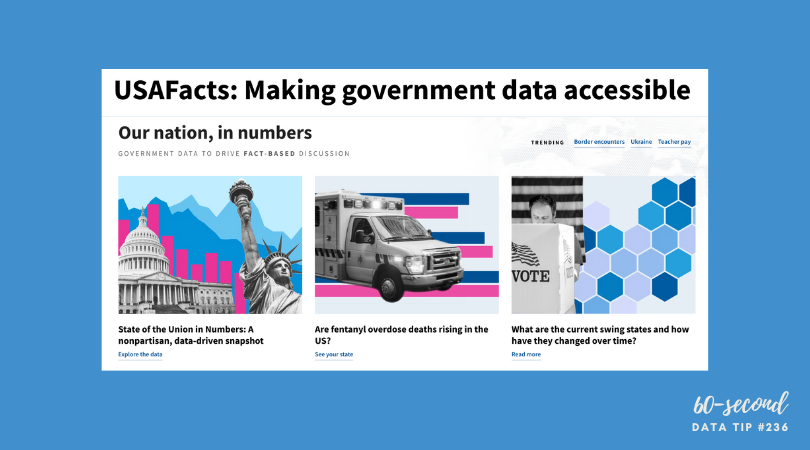Here’s a new addition to my highly-curated resources list: USAFacts. I occasionally write a 60-second data tip describing a particular resource, including why I think it’s cool. And I link each of these tips to a resources list on my website.
What is it?
USAFacts is dedicated to making government data more accessible. The idea is to help people understand where their tax dollars are going and to help those working on issues of concern in the philanthropic, nonprofit, and public sectors to easily access information to inform their decisions.
Who’s it for?
The general public, policymakers, philanthropists, nonprofit managers, and researchers, among others.
Who’s behind it?
After he retired from tech and began to focus on philanthropy, former Microsoft CEO Steve Ballmer wanted to understand what the government spends on programs to help people and the outcomes of those programs. However, unlike businesses, US governments are not mandated to compile reports on their expenditures. He then hired data analysts to compile this data, and this was the origin of USAFacts, a not-for-profit, nonpartisan civic initiative which is solely funded by Ballmer.
Why I think it’s cool
It’s free and the data is shared under a Creative Commons license. They only ask that you credit USAFacts when using their curated material. Most of their data is visualized and all of it is well-documented. Charts can be easily downloaded in an image format or embedded into your website using an embed code like the chart below.
Let’s talk about YOUR data!
Got the feeling that you and your colleagues would use your data more effectively if you could see it better? Data Viz for Nonprofits (DVN) can help you get the ball rolling with an interactive data dashboard and beautiful charts, maps, and graphs for your next presentation, report, proposal, or webpage. Through a short-term consultation, we can help you to clarify the questions you want to answer and goals you want to track. DVN then visualizes your data to address those questions and track those goals.


































